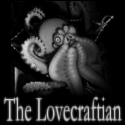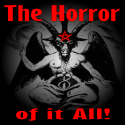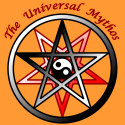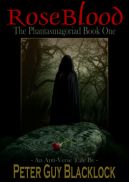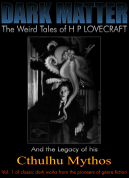 The Druids in Fact, Folklore and Fiction – Part One
The Druids in Fact, Folklore and Fiction – Part One
The Druids were a high-ranking priestly class among the Iron Age Celtic Peoples of Europe, they were at their most influential within Celtic society starting sometime between the 8th and 3rd centuries BCE up until the 1st century CE when the Romans started to prohibit their activities. Little is actually known about the Druids and their practices for they kept no written records themselves, having a purely oral tradition. It is only from a few (probably biased) contemporary snippets of information given by Classical writers that any details can be gleaned, though perhaps also some can be (cautiously) deduced from later Early-Medieval British and Irish histories, myths and folktales, as well as from other surviving folklore that can be reasonably sourced to an ancient Celtic origin. Practically everything we know about the Druids is hugely debatable – and that even includes the meaning of the word itself.
Part One of this article, presented here, will take a thorough look at those snippets that are provided by contemporary writers and will try to assess the veracity of the information they provide. We’ll take a brief look at the Celts and their beliefs, at the role of the Druids themselves, at the bloody rites they were involved in, at the undoubted existence of female Druids and finally at how they disappeared from the historical record and became the stuff of legend and folklore. Part Two will look at how popular perceptions of the Druids have changed over the years, taking in misconceptions regarding the Druids, the Druid Revival of the 17th and 18th centuries, Neo-Druidism in the 19th and 20th centuries and how Druidism has been depicted in fiction – from the Romanticism movement onwards – in film and then games – specifically fantasy role-playing-games. But first, what does the word Druid actually mean?
The etymology of the term ‘Druid’

Fanciful illustration of ‘An Arch Druid in His Judicial Habit’, from “The Costume of the Original Inhabitants of the British Islands” by S.R. Meyrick and C.H. Smith (1815), though the gold gorget collar is copying Irish Bronze Age examples not Iron Age.
The word Druid is the Modern-English variant of a latinised Gaulish term Druida – derived from the proto-Celtic compound dru-wid- (‘strong seer’ – or ‘all seeing’ perhaps), which itself is derived from the proto-Indo-European roots deru-weid (deru – to be firm, solid or steadfast, and weid – to see). The word was pluralised by Latin scholars as druidae, a term also used by the ancient Greeks – along with druidēs (δρυΐδης). Compare the Old-Irish drai and the Modern-Irish draoi, meaning ‘magician’ or ‘sorcerer’; also the Old Cornish druw and the Middle-Welsh dryw, meaning ‘seer’ aswell as ‘wren’ – a bird traditionally connected with augury (interpreting omens, one of the roles of a Druid).
A persistent definition comes from a link between the Celtic dru and the Greek drus (oak), so therefore, it goes, Druid means ‘oak seer’ or ‘seer of the oak’, but there is no reason to link a Greek word with a Celtic one, especially considering the Modern-Irish word for ‘oak’ is dair and the Cornish word is derw (though the Welsh is the more appropriate drew – but this is not reflected in the Modern-Welsh reconstruction of Druid as Derwydd). This ‘oak-seer’, or sometimes ‘oak-knower’, interpretation seems to have originated with Pliny the Elder in the 1st century CE, in his Natural History he considered the word to contain the Greek noun drýs (δρύς), ‘oak-tree’ and the Greek suffix -idēs (-ιδης), ‘belonging to’… so, technically ‘oak-tree-ite’ or ‘of the oak-tree’? That presumes a literal Greek translation correctly transliterates into a Gaulish word. This, added with the known significance of the oak tree to the Celts in general, and to the Druids specifically, was enough to cement the ‘oak seer’ meaning popularly, almost in to perpetuity (it’s still used on Wikipedia).
Although the Greek word drus is derived from the same proto-Indo-European root (deru) as Druid, so are many other words in various Indo-European derived languages – including; Sanskrit dāru (wood, timber), Old Norse tryggr (firm, true), Old English trēowth (faith, loyalty or truth – from Germanic treuwithō). Likewise, the Indo-European weid has many later derivatives – including; Old English wit or witt (knowledge, intelligence), Germanic witan (to know), Old High German wīzag (knowledgeable or wise). So using the same logic as that for the ‘oak seer’ meaning we could also claim that Druid means ‘oak knower’, ‘wood wise’ or ‘truth seer’, along with potentially hundreds of other combinations.
The Celts, their Beliefs and their Gods:
The ancient Celts were an animist-pagan people of Indo-European stock, not so much a single ethnicity or nation but more a collection of tribes with a common celtic language base and a loose cultural unity that spread throughout Western, Central, and parts of Eastern Europe from about the 8th century BCE. The long established view is that they originated from around the upper Danube region at that time, then later spread to the north-west and south-east; though a current (prevailing?) view is that they started in the west much earlier than the 8th century BCE along the Atlantic fringe and spread eastwards from there – some linguistic and archaeogenetic evidence seems to support this hypothesis. Where-ever their origin, they threatened Greece and Rome from the 4th to the 2nd centuries BCE and their influence, at its peak, reached from Italy in the South to the British Isles in the North, and from Spain in the West to Turkey in the East. They were a warrior society and a fiercely tribal one, that often warred among themselves as well as with outsiders, who were skilled horse riders and charioteers. Celtic settlements were typified by the use hill-forts and homesteads with extensive agricultural field systems. Although a largely agrarian society there were some urban centres, especially among the continental Celts.

Map showing the ‘standard model’ for the expansion of Celtic culture into the east and west from central Europe, starting around 800 BCE.
The Greco-Roman view of the Celts is typified by the Greek historian Diodorus Siculus, in his Bibliotheca historica (Historical Library, c. 36-30 BCE) he relates “The Gauls [the Celts that largely populated what is now France] are terrifying in appearance and speak with deep, harsh voices. They speak together in few words, using riddles which leave much of the true meaning to be understood by the listener. They frequently exaggerate their claims to raise their own status and diminish another’s. They are boastful, violent, and melodramatic, but very intelligent and learn quickly.”
Numerous Classical accounts describe the Celts as animists, holding that all of nature is sacred. The elements, the land and its features, the seas and rivers, the animals and plants, all are possessed by spirits and deities that require proper placation and respect. Their sacred spaces and shrines tended to be focused on natural features; oak groves, wells, springs etc., rather than temples or churches – though they often built ritual complexes around, or close to, larger or particularly holy sites. The Celts were great believers in the effectiveness of votive offerings to gain favor with, placate or thank the nature spirits and deities involved with particular places and activities. Some of these offerings would have apparently been made in anticipation of the achievement of a particular wish, but more often, it seems, the offering was made after the wish had been fulfilled. These votive offerings, often items of great status, were thrown into wells, lakes, rivers and even pits in the ground or tied to trees – anywhere that was considered sacred or a liminal link to the worlds of the water, underworld or sky gods.
The mundane and the supernatural were intricately interwoven and ritual was a big part of everyday life when dealing with all things and practices, whether considered (by today’s standards at least) sacred or profane, for the Celts probably did not see any distinction between the two – all was sacred. It is also well documented that the Celtic Peoples believe in what is commonly termed the Pythagorean doctrine among the Classical descriptions – the Greek scholar Alexander Cornelius Polyhistor (c. 100 BCE) perhaps sums it up best, “The Pythagorean doctrine prevails among the Gauls’ teaching that the souls of men are immortal, and that after a fixed number of years they will enter into another body.”
The Celts particular admiration of mistletoe and the oak tree is discussed by Pliny the Elder, in his Naturalis Historia (Natural History, 1st century CE) “The Druids, for that is the name they give to their magos [magicians], held nothing more sacred than the mistletoe and the tree that bears it, supposing always that tree to be the robur [a hard timbered oak]. Of itself the robur is selected by them to form whole groves, and they perform none of their religious rites without employing branches of it; so much so, that it is very probable that the priests themselves may have received their name from the Greek name for that tree. In fact, it is the notion with them that everything that grows on it has been sent immediately from heaven, and that the mistletoe upon it is a proof that the tree has been selected by [the] god himself as an object of his especial favour.”
The Celts were also polytheists (pagan) in that they had many gods and goddesses in a pantheon that can be readily comparable to other Indo-European religions, each linked to aspects of life and the natural world. According to Julias Caeser’s Commentarii de Bello Gallico (The Gallic Wars, c. 50 BCE), “The chief god of the Gauls is Mercury and there are images of him everywhere. He is said to be the inventor of all the arts, the guide for every road and journey, and the most influential god in trade and moneymaking. After him, they worship Apollo, Mars, Jupiter, and Minerva. These gods have the same areas of influence as among most other Peoples. Apollo drives away diseases, Minerva is most influential in crafts, Jupiter rules the sky, and Mars is the god of war.” He also tells us that “The Gauls all say that they are descended from the god of the dark underworld, Dis, and confirm that this is the teaching of the Druids. Because of this they measure time by the passing of nights, not days. Birthdays and the beginnings of months and years all start at night.” It is unfortunate – and characteristically Roman – that Caesar only gives the Roman names for the deities mentioned and not their Gaulish equivalents. The identification and naming of the comparative deities across the Celtic tribes and later nations is a massive undertaking in and of itself – so much so that it requires a separate article all its own, which will be linked to here when done.

Some typically boisterous ancient Celts with some typically British Celtic round houses in the background.
The Festivals
The ancient Celtic Peoples celebrated four major festivals throughout the year, connected to the pastoral seasons they were commonly termed fire festivals for they each involved the lighting of ritual fires. The solar festivals, the solstices and the equinoxes, were probably also celebrated but it seems these did not hold the same importance to the Celts. The first of the fire festivals marks the beginning of the Celtic year, in the same way that days were measured from when the dark of night sets in (sunset) – the year is measured from when the dark of winter sets in. The ‘First Day of Winter‘, known in Wales as Calan Gaeaf , in Cornwall as Kalan Gwav, and in Brittany Kalan Goañv, is most famously known under its Irish Gaelic name Samhain (Samhainn/Samhuinn in Scottish Gaelic and Sauin in Manx Gaelic), which probably means ‘Summer’s end’ but may also simply mean ‘assembly’. Essentially this was a celebration of the ‘meat harvest’, a time when animals were brought back down from the summer pastures and livestock was slaughtered for the coming winter. By todays calendar it is celebrated from the evening of the 31st October (which became the christianised Halloween) into the 1st of November (which became the christianised All Saints Day).
The second fire festival marks the beginning of Spring and is called in Ireland Imbolc or Imbolg (which may mean ‘in the belly’, referring to the pregnancy of ewes) and Brigid’s Day (Irish: Lá Fhéile Bríde, Scottish Gaelic: Là Fhèill Brìghde and Manx: Laa’l Breeshey). According to the 10th century CE Sanas Cormaic (Cormac’s Glossary) Imbolc is derived from oimelc, “ewe’s milk” and indeed, because of this, the festival, a celebration of the lambing season, is now sometimes called Oimelc. Brigid (Brigit or Brig) is the Gaelic name for the Celtic goddess, possibly connected to Gallo-Roman and Romano-British Brigantia, derived from the Indo-European deity of the dawn associated with Spring, fertility, healing, poetry and smithcraft. In the modern calendar this festival falls on the evening of the 31st of January and into the 1st of February (which became christianised as Saint Brigid’s Day). In Wales the equivalent festival is now known as Gŵyl Fair y Canhwyllau (Mary’s Festival of the Candles), and is transposed to the Christian feast day of Candlemas, which is celebrated on the 2nd of February.
The third fire festival, that marks the beginning of Summer, is most commonly known by its Anglicised name of Beltane – in Irish it is Lá Bealtaine, in Scottish Gaelic Là Bealltainn and in Manx Gaelic Laa Boaltinn/Boaldyn. In Wales it is known as Calan Mai (first day of May) or more usually Calan Haf (first day of Summer). Beltane is usually ascribed the meaning of ‘bright fire’ but it may also mean ‘Bel’s fire’, Bel being Belenus (also Belenos, Belinus, Beli Mawr) the Sun God, one of the most ancient and most widely worshiped Celtic deities. A festival of the waxing sun, it was a time for the livestock to be taken out to the summer pastures – often driven between two fires – and of rituals to protect crops, dairy products and people, and to encourage growth. It’s modern cognate is May Day, the 1st of May.
The fourth fire festival is known as Lughnasadh in Irish Gaelic – a combination of the god Lugh and násad (an assembly) – Scottish Gaelic: Lùnastal, Manx: Luanistyn, and it marks the beginning of the main harvest season and the end of the hay harvest that had begun after Midsummer. According to Irish myth, the festival had been begun by Lugh as a funeral feast and athletic competition in commemoration of his mother Tailtiu – who may have been an earth goddess who represented the dying vegetation that fed mankind. In Welsh it is known as Gŵyl Awst (feast of August) or Calan Awst (first day of August), but in the majority of Britain, and beyond, it is known as Lammas Day from Old English hlafmæsse (loaf mass) – the 1st of August.
The Role of the Druids:
The Druids were central to Celtic society, they were a powerful and influential priestly caste whom Pliny the Elder described as “that tribe of diviners and physicians”, open to both males and females (though you wouldn’t know from the earliest accounts – but more on that later), with tenuous hints at shamanism, and believed to have originated in Britain where the great ‘schools’ were said to be based. They were responsible for the passing on of wisdom in theology, philosophy, science, medicine, history and law, acting as teachers, herbalists, advisors, arbiters, judges and possibly mediums, as well as bards, seers and priests conducting religious and sacrificial rites. Whether all Druids carried out all these functions, or whether there were branches of different sub-classes of Druid that carried out some of them and not others, is debatable.

Druids among the groves – from National Geographic’s The Truth Behind: Secrets of the Druids.
The earliest record of the Druids seems to have come from two Greek, now non-extant, texts of c. 300 BCE. Diogenes Laertius refers to them in the introduction to his Vitae of the 2nd century BCE: “Some say that the study of philosophy originated with the barbarians. In that among the Persians there existed the Magi, and among the Babylonians or Assyrians the Chaldaei, among the Indians the Gymnosophistae, and among the Celts and Gauls men who were called Druids and Semnothei, as Aristotle relates in his book on magic, and Sotion in the twenty-third book of his Succession of Philosophers.” Semnothei is probably another name for a Druid, though it could be a sub-class. Here is a short list of synonyms for (or possibly sub-classes of) Druid that are mentioned in the ancient texts:
- Semnothei (priest – a Latinised Celtic word, literally “reverer of the gods”) used by Diogenes Laertius
- Bardi (bard- a poet/composer – a Latinised Celtic word) used by Ammianus, Diodorus and Strabo,
- Vates (poetic prophet/diviner – Latinised Celtic, cognate with the Old-Irish Fáith – Modern-Irish fili – the Welsh Gwawd and the English Ovate) used by Strabo,
- Seer (prophet/diviner) used by Diodorus,
- Eubages (unknown – possibly a philosopher, teacher) used by Ammianus,
- Saronidae (seems to be a synonym of Druids – Latinised Celtic, possibly compounded from sêr, ‘stars’ and honydd, ‘one who discriminates or points out’ and is probably related to the Old-Welsh Seronyddion, ‘astronomer’) used by Diodorus.
- Gutuatri (masters, or priests, of particular sancturies – Latinised Celtic, from gutu ‘voice’, perhaps meaning ‘speakers or voice of the gods’) known from a few inscriptions and from Aulus Hirtius’ addition to Commentarii de Bello Gallico which mentions a gutuatros put to death by Caesar.
With this plethora of names many have tried to delineate up to five distinct sub-classes, offices or orders of Druid, though most classical writers limit themselves to three. A closer look at the meaning of these words (and their context within the ancient texts) may prove this delineation to be folly – as will be discussed in the following paragraphs.

Druids Inciting the Britons to Oppose the Landing of the Romans – from Cassell’s History of England, Vol. I.
Perhaps the most detailed account of the Druids, and potentially one of the few first-hand accounts, has no distinction of sub-classes what-so-ever. It comes from Julius Caesar’s Commentarii de Bello Gallico, in which he claims that there are only two orders of men who are of any rank and dignity among the Gauls; the Druids and the Equites (knights or warrior-elite), the rest, he asserts, are little more than slaves. Of these two orders, it is the Druids that “are engaged in things sacred, conduct the public and the private sacrifices, and interpret all matters of religion. To these a large number of the young men resort for the purpose of instruction, and they [the Druids] are in great honor among them. For they determine respecting almost all controversies, public and private; and if any crime has been perpetrated, if murder has been committed, if there be any dispute about an inheritance, if any about boundaries, these same persons decide it; they decree rewards and punishments; if any one, either in a private or public capacity, has not submitted to their decision, they interdict him from the sacrifices. This among them is the most heavy punishment. Those who have been thus interdicted are esteemed in the number of the impious and the criminal: all shun them, and avoid their society and conversation, lest they receive some evil from their contact; nor is justice administered to them when seeking it, nor is any dignity bestowed on them. Over all these Druids one presides, who possesses supreme authority among them [i.e a High- or Arch-Druid]. Upon his death, if any individual among the rest is pre-eminent in dignity, he succeeds; but, if there are many equal, the election is made by the suffrages of the Druids; sometimes they even contend for the presidency with arms. These assemble at a fixed period of the year in a consecrated place in the territories of the Carnutes, which is reckoned the central region of the whole of Gaul. Hither all, who have disputes, assemble from every part, and submit to their decrees and determinations. This institution is supposed to have been devised in Britain, and to have been brought over from it into Gaul; and now those who desire to gain a more accurate knowledge of that system generally precede thither [to Britain] for the purpose of studying it.” This last passage seems to be the main, and possibly only, source for the idea that Druidism originated in Britain. It may be so, but many have since extrapolated Druidism as a native ‘British’ religion older than the Celts themselves, that spread among Celtic culture once it reached Britain’s misty shores. An attractive idea – but pure speculation.
He continues, “The Druids do not go to war, nor pay tribute together with the rest; they have an exemption from military service and a dispensation in all matters. Induced by such great advantages, many embrace this profession of their own accord, and [many] are sent to it by their parents and relations. They are said there to learn by heart a great number of verses; accordingly some remain in the course of training twenty years. Nor do they regard it lawful to commit these to writing, though in almost all other matters, in their public and private transactions, they use Greek characters [though that changed to Latin as the Romans annexed Gaul]. That practice they seem to me to have adopted for two reasons; because they neither desire their doctrines to be divulged among the mass of the people, nor those who learn, to devote themselves the less to the efforts of memory, relying on writing; since it generally occurs to most men, that, in their dependence on writing, they relax their diligence in learning thoroughly, and their employment of the memory. They wish to inculcate this as one of their leading tenets, that souls do not become extinct, but pass after death from one body to another, and they think that men by this tenet are in a great degree excited to valor, the fear of death being disregarded. They likewise discuss and impart to the youth many things respecting the stars and their motion, respecting the extent of the world and of our earth, respecting the nature of things, respecting the power and the majesty of the immortal gods.” It should be noted that Caesar makes no mention of Bards or of any form of divination or prophesying, but this may be because he is coming at the subject as a pragmatic soldier and comments only on those aspects of the Druids that are pertinent to him and his campaigns in Gaul.
The Roman orator Marcus Tullius Cicero’s philosophical treatise in the form of a dialogue De Divinatione (On Divination, 44 BCE) gives us this quote which can almost be imagined as something he may have said to his friend, non other than Julius Caesar himself: “Nor is the practice of divination disregarded even among uncivilized tribes, if indeed there are Druids in Gaul — and there are, for I knew one of them myself, Diviciacus, the Aeduan, your guest and eulogist. He claimed to have that knowledge of nature which the Greeks call physiologia [physics—the inquiry into natural causes and phenomena], and he used to make predictions, sometimes by means of augury and sometimes by means of conjecture.” This individual, the only Druid from antiquity whose existence is attested to by name, was known to Caesar as the chief diplomat appointed by the Gauls to petition the general during his campaign – though Caesar makes no mention of him being a Druid in his accounts, he does mention that he was elected magistrate (a Druidic role) among his people. Diviciacus met Cicero in 63 BCE when he travelled to Rome to ask the Roman Senate for military aid.

A Welsh Druid playing the Harp.
The Bardi
Diodorus states that the Gauls “have lyric poets called Bardi, who, accompanied by instruments resembling lyres, sing both praise and satire. They have highly honoured philosophers and priests called Saronidae [Druids]. They also make use of Seers, who are greatly respected. These Seers, having great authority, use auguries [predict the future by observing the flight and calls of birds] and sacrifices to foresee the future.” He goes on, “They do not sacrifice or ask favours from the gods without a Saronidae present, as they believe sacrifice should be made only by those supposedly skilled in divine communication. Not only during peacetime but also in war, the Gauls obey with great care these Druids and singing poets, both friend and enemy alike. Often when two armies have come together with swords drawn these men have stepped between the battle-lines and stopped the conflict, as if they held wild animals spell-bound.” Diodorus initially suggests that the Bardi, Seers and Saronidae or Druids were separate entities, but then later seems to lump both the Bardi and the Seers together as “singing poets” – so perhaps they are connected? Perhaps not.
The Vates
Strabo, a Greek geographer, philosopher, and historian, states in his Geographica (Geography, c. 7 BCE-23 CE), “As a rule, among all the Gallic Peoples three sets of men are honoured above all others: the Bards, the Vates, and the Druids. The Bards are singers and poets, the Vates overseers of sacred rites and philosophers of nature, and the Druids, besides being natural philosophers, practice moral philosophy as well. They are considered to be the most just and therefore are entrusted with settling both private and public disputes, so that in earlier times they even arbitrated wars and could keep those intending to draw themselves up for battle from so doing and it was to these men most of all that cases involving murder had been entrusted for adjudication. And whenever there is a big yield from these cases, they believe that there will come a yield from the land too. Both these men and others aver that the human soul and the universe are imperishable, although both fire and water will at some times prevail over them.” This seems to suggest that the Bards, Vates and Druids were separate entities, but the descriptions of the Vates and Druids are barely distinguishable – the Vates oversee sacred rites and the Druids practice moral philosophy, but they are both natural philosophers – and there is no mention of the Vates presumable role as Seers, though this may be because the use of the name Vate makes it implicit.
The Eubages
Ammianus Marcellinus, a Roman historian (c. 4th century CE), recorded of Gaul in his Roman History, “Throughout these provinces, the people gradually becoming civilized, the study of liberal accomplishments flourished, having been first introduced by the Bards, the Eubages and the Druids. The Bards were accustomed to employ themselves in celebrating the brave achievements of their illustrious men, in epic verse, accompanied with sweet airs on the lyre. The Eubages investigated the system and sublime secrets of nature, and sought to explain them to their followers. Between these two came the Druids, men of loftier genius, bound in brotherhoods according to the precepts and example of Pythagoras; and their minds were elevated by investigations into secret and sublime matters, and from the contempt which they entertained for human affairs they pronounced the soul immortal.” Though the role of Bards is clearly stated here, and conforms to previous passages, the roles of the Eubages and the Druids are less clearly delineated – though the Eubages seem to be teachers of the people – and again, there is no mention of divination – or the overseeing of rites – for either of them.
Taking all these passages, and the etymology of the words where known, into account I wonder if the Bards were a distinct class of more secular (if such a thing can be said of anything to do with the ancient Celts) poets and minstrels who recited and performed heroic tales and histories. They may have been taught in the Druidic ‘schools’, but they were not actually Druids themselves, and, though still respected, probably had a much lower social standing and level of influence – perhaps explaining why Caesar did not mention them. The rest of the terms mentioned above, I believe, are probably all synonyms or specialisations of Druid (the true distinctions of which were probably rather fuzzy to the Greek and Roman chroniclers) – Vates seem to have been divinely inspired prophets, poets and minstrels, as well as overseers of sacred rites and philosophers of nature; Seers were prophets, auguries and overseers of divinatory rites; Eubages were natural philosophers and teachers; Saronidae were natural philosophers, priests and astronomers; and the Semnothei were priests, moral philosophers and intermediaries with the gods. Some of these specialisations clearly overlap and all of the attributes alloted to them have also been assigned to the Druids as a whole, so I think it fair to assume that they all were Druids – perhaps a Druid could be any of them according to whatever function or role needed carrying out. The role of Vate and the Seer may be one and the same, as might Saronidae and Semnothei.
The Sacrificial Rites of the Druids:
There can be no doubt that the ancient Celts performed sacrificial rites, as did all of the ancient pagan cultures, but the idea that they performed human sacrifices, and even ritual cannibalism, has been a rather contentious subject in the modern period. It has been a long standing tendency since the ‘Druid Revival’ of the 18th century CE to dismiss all the classical accounts of such as simply biased propaganda. But, is it really that simple? No, it is not. First, we must remember that the Celts ritualised almost every aspect of their lives – and that includes death and execution – what may appear to the Classical authors as ritualised human sacrifices dedicated to dark, primitive gods, may in fact simply be the executions of criminals and prisoners of war that have an added ritual component. So, let us have a look at some of those classical accounts:

An 18th century illustration of a wicker man, the form of execution that Caesar claimed the druids used for human sacrifice. From the “Duncan Caesar”, Tonson, Draper, and Dodsley edition of the Commentaries of Caesar translated by William Duncan published in 1753.
Julius Caesar seems to delight in telling us, “The nation of all the Gauls is extremely devoted to superstitious rites; and on that account they who are troubled with unusually severe diseases, and they who are engaged in battles and dangers, either sacrifice men as victims, or vow that they will sacrifice them, and employ the Druids as the performers of those sacrifices; because they think that unless the life of a man be offered for the life of a man, the mind of the immortal gods can not be rendered propitious, and they have sacrifices of that kind ordained for national purposes. Others have figures of vast size, the limbs of which formed of osiers they fill with living men, which being set on fire, the men perish enveloped in the flames. They consider that the oblation of such as have been taken in theft, or in robbery, or any other offense, is more acceptable to the immortal gods; but when a supply of that class is wanting, they have recourse to the oblation of even the innocent.” Granted, this infamous ‘wicker-man rite‘ does beggar belief… and I feel that Caesar is probably guilty of exaggeration at least, but is it really any more unbelievable than using crucifixion to execute your criminals on a massive scale – sometimes thousands at a time? He also tells us that “the funerals of the Gauls are magnificent and extravagant. Everything which was dear to the departed is thrown into the fire, including animals. In the recent past, they would also burn faithful slaves and beloved subordinates at the climax of the funeral.”
Caesar also informs us that “Before a great battle, they will often dedicate the spoils to Mars. If they are successful, they will sacrifice all the living things they have captured and other spoils they gather together in one place. Among many tribes, you can see these spoils placed together in a sacred spot. And it is a very rare occasion that anyone would dare to disturb these valuable goods and conceal them in his home. If it does happen, the perpetrator is tortured and punished in the worst ways imaginable.”
Strabo, before confirming the ‘wicker-man rite’, tells us that the Gauls “used to strike a human being, whom they had devoted to death, in the back with a sabre, and then divine from his death-struggle. But they would not sacrifice without the Druids. We are told of still other kinds of human sacrifices; for example, they would shoot victims to death with arrows, or impale them in the temples, or, having devised a colossus of straw and wood, throw into the colossus cattle and wild animals of all sorts and human beings, and then make a burnt-offering of the whole thing.”
Diodorus, when speaking of the druidic Seers who make sacrifices to foresee the future, relates a few more details, “When seeking knowledge of great importance, they use a strange and unbelievable method: they choose a person for death and stab him or her in the chest above the diaphragm. By the convulsion of the victim’s limbs and spurting of blood, they foretell the future, trusting in this ancient method.” Too detailed a description I feel to be just dismissed as propaganda. He also tell us that the Gauls carry out other “particularly offensive religious practices. They will keep some criminal under guard for five years, then impale him on a pole in honor of their gods—followed by burning him on an enormous pyre along with many other first-fruits [usually a religious offering of the first agricultural produce of the harvest, so perhaps a Lughnasadh ritual – but see below for another possible meaning]. They also use prisoners of war as sacrifices to the gods. Some of the Gauls will even sacrifice animals captured in war, either by slaying them, burning them, or by killing them with some other type of torture.” Could his “enormous pyre” also be another version of the wicker-man rite?
Diodorus also passes on this salacious little tidbit, not about the Druids specifically, but about the Celts generally and their apparent cult of the severed head: “They cut off the heads of enemies slain in battle and attach them to the necks of their horses. The blood-stained spoils they hand over to their attendants and striking up a paean and singing a song of victory; and they nail up these first-fruits upon their houses, just as do those who lay low wild animals in certain kinds of hunting. They embalm in cedar oil the heads of the most distinguished enemies, and preserve them carefully in a chest, and display them with pride to strangers, saying that for this head one of their ancestors, or his father, or the man himself, refused the offer of a large sum of money. They say that some of them boast that they refused the weight of the head in gold.”

Illustration showing some Celtic warriors – the mounted swordsman has a number of severed heads hanging from his horse’s neck. © Angus McBride
Tacitus, the Roman senator and historian, in his Annals (c. 110 CE), writes that the Britons’ “religious groves [were] dedicated to superstition and barbarous rites” and that “the natives [stained] their altars with the blood of their prisoners, and in the entrails of men explored the will of the gods.” It would be so easy to dismiss such accounts as just Roman prejudice and propaganda but I think that would be doing the Roman historians, the testimonies of whom we are so willing to accept in most other regards, a disservice – and, are we to believe that the Greek historians were just as prejudiced?
Marcus Annaeus Lucanus (more commonly known as just Lucan), in his epic poem Pharsalia or De Bello Civili (On the Civil War, 1st century CE), while writing about the end of Caesar’s Gaulish campaigns – as well as giving us names to three of that nation’s deities – grimly waxes lyrical about the bloody rites of the Druids:
“Cruel Teutates pleased by dreadful blood,
Horrid Esus with his barbaric altars,
and Taranis, more cruel than Scythian Diana.
Oh Druids, now that the war is over
you return to your barbaric rites and sinister ways.
You alone know the ways of the gods and powers of heaven,
or perhaps you don’t know at all.
You who dwell in dark and remote forest groves,
you say that the dead do not seek the silent realm of Erebus
or the pale kingdom of Pluto,
but that the same spirit lives again in another world
and death, if your songs are true, is but the middle of a long life.”
A 10th century CE manuscript called the Commenta Bernensia (A.K.A. the Bern scholia) includes commentaries and marginalia related to Lucan’s Pharsalia. It expands on that poem’s references to the Gaulish gods mentioned and druidic human sacrifices associated with them. It states that victims dedicated to Teutates (whom it equates with Mercury) were drowned, those dedicated to Esus (equated here with Mars) were hanged/suspended from trees and ritually wounded, while those to Taranis (equated with Jupiter) were burned. The authors and sources for these comments are unknown but many modern scholars link these scholium with the notion of three-fold death, a proposed ritual sacrificial practice in Indo-European societies that are persistently referenced in both Celtic and Germanic mythologies.
Two good examples of three-fold death from Welsh legend (pre-12th century CE) are mentioned in the story of Myrddin Wyllt (Myrddin the Wild – one of the sources for the Merlin of Arthurian legend). As a test of his skill, Myrddin is asked to prophesy how a boy will die. He says the boy will fall from a rock. The same boy, but with a change of clothes, is presented again, and Myrddin prophesies that he will hang. Then the boy is presented dressed in a girl’s clothes, and Myrddin replies, “Woman or no, he will drown.” Later in life, as a young man, the boy concerned falls from a high precipice during a hunt, he is caught in a tree and hangs head down in a river, where he drowns. Myrddin himself also dies in a three-fold manner, this time by a fall, a piercing, and drowning – an event he also prophesied. A gang of shepherds drove him off a cliff, where he was impaled on a stake left by fishermen, and died drowning with his head below the water. It is often a factor in these many tales of three-fold death that they are prophesied before hand or that they are the result of a curse.
Is there any archaeological evidence to back up these claims of human sacrifice? Unfortunately there is very little physical evidence for the Druids at all – but, there is evidence that, in Britain at least, foundation sacrifices occurred from the Neolithic time to the Roman era, these sacrificial victims were placed into the foundations of buildings and other structures. Also, we can point to Lindow Man, the preserved bog body of a man discovered (1983 CE) in a peat bog at Lindow Moss in Cheshire, North West England – a high-status, fit, young man who may have been sacrificed willingly some time between 2 BCE and 119 CE. He was apparently strangled, hit on the head, and had his throat cut – a three-fold death possibly dedicated to three separate gods – and traces of mistletoe were found in his well preserved gut.
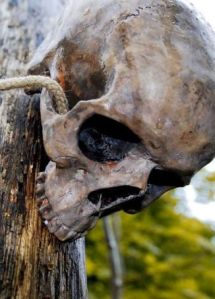
Cult of the severed head – from National Geographic’s The Truth Behind: Secrets of the Druids.
With regards to the cult of the severed head, the Celts’ reputation as head hunters is well evidenced in both the Classical sources and the archaeological record. The Celtic Peoples seem to have had a great reverence for the human head, apparently seeing it as the centre of the soul, emotions and of life itself. The severed head is a motif that appears regularly in sculptured representations and in later Celtic folk-tales and legends – the British Sir Gawain and the Green Knight and the Irish Ulster Cycle are but two of many. The practise was probably a warrior tradition, rather than a religious one, but it does lend credence to the bloodthirstiness of the Celtic Peoples as a whole.
We may also be able to point to the finds from a cave in Alveston, England, that were discovered recently (2000 CE), as evidence of human sacrifice. The bones of as many as 150 people, who show evidence of skull-splitting blows and dating back to about the time of the Roman conquest, were found – archaeologists believe they may have been the victims of a large sacrificial event. One bone from this cave, a human femur, may even provide evidence of ritual cannibalism. It had been deliberately split longitudinally just as one would do to extract the marrow, though personally I feel this would be more to do with starvation than ritual. Having said that…
After Pliny the Elder reassured us that “we can be glad that the Romans have wiped out the murderous cult of the Druids,” he goes on and says that they “thought human sacrifice was considered an act pleasing to the gods and eating the victim was thought to be beneficial to one’s health.” Again, it would be easy to dismiss this as prejudiced hyperbole (especially the ritual cannibalism part), but it is Pliny that, among a discussion of the properties of mistletoe, gives us the most detailed account of the trappings involved in a Druidic sacrificial rite that is available to us – this one involving bulls though, not humans: “The mistletoe, however, is but rarely found upon the robur; and when found, is gathered with rites replete with religious awe. This is done more particularly on the fifth day of the moon, the day which is the beginning of their months and years, as also of their ages, which, with them, are but thirty years. This day they select because the moon, though not yet in the middle of her course, has already considerable power and influence; and they call her by a name which signifies, in their language, the omnia sanantem [all-healing]. Having made all due preparation for the sacrifice and a banquet beneath the trees, they bring thither two white bulls, the horns of which are bound then for the first time. Clad in a white robe the priest ascends the tree, and cuts the mistletoe with a golden sickle, which is received by others in a white sagum [military cloak]. They then immolate the victims, offering up their prayers that (the) god will render this gift of his propitious to those to whom he has so granted it. It is the belief with them that the mistletoe, taken in drink, will impart fecundity to all animals that are barren, and that it is an antidote for all poisons.” Although Pliny is the only authority to mention this ceremony, the main elements of his account – including oak trees, mistletoe, ritual banqueting, the moon, and bull-sacrifice – are all features of Celtic religion that are confirmed elsewhere. Pliny’s source for this information is unknown, but it may have been Posidonius of Rhodes, a polymath who flourished in the 1st century BCE and whose large body of work is now largely lost. It is probably the case that a good deal of what the Classical writers tell us of the ancient Celts is in fact sourced from Posidonius, who visited and travelled among them for a while.
Female Druids:

A rather flimsily dressed female Druid with the Gaulish hero Vercingetorix, from Histoire Nationale des Gaulois sous Vercingetorix. By Ernest Bosc 1882.
According to Strabo, Posidonius can definitely be credited with the following strange tale: “there is a small island in the Atlantic Ocean at the mouth of the Loire River inhabited by women of the Samnitae [Namnitae or Namnetes] tribe. They are possessed by Dionysus and appease this god by mysterious ceremonies and other types of sacred rituals. No man ever comes to this island, but the women sail to the mainland to have sex with men, then return. Each year the women take down the roof of a temple and build it again before dark, with each woman carrying a load to add to the roof. Whoever drops her load is torn to pieces by the others. They then carry the pieces of her around the temple shouting with a Bacchanalian cry until their mad frenzy passes away. And it always happens that the one who is going to suffer this fate is bumped by someone.” This story may seem farfetched, but within, I think, are the grains of truth – the wet, windy climate of Western Gaul made it likely that the thatched roofs of dwellings (made from branches, reeds and straw) would have to be redone every year; secondly, according to Pliny the Elder, a common religious practice amongst the Celts was to not drop new materials; and thirdly, Poseidonios attests that circumambulation was a known part of Celtic rites. This island could be Île d’Yeu , just off the Vendée coast of western France – or possibly one of the twin islands Houat and Hoëdic, they’re smaller, but slightly closer to the Namnetes’ tribal coast. Are the women, who practise mysterious ceremonies and sacred rituals there, female Druids? They certainly seem to be priestesses of the Gaulish equivalent to Greek Dionysus and Roman Bacchus – perhaps they were a Celtic version of the Greek maenads.
The island women mentioned above may be similar to those attested to, a little less sensationaly, by Pomponius Mela, c. 43 CE, on an island up to 200km away – Île de Sein off Pointe du Raz, Finistère, western Brittany: “Sena, in the Britannic Sea, opposite the coast of the Osismi, is famous for its oracle of a Gaulish god, whose priestesses, living in the holiness of perpetual virginity, are said to be nine in number. They call them Gallizenae, and they believe them to be endowed with extraordinary gifts to rouse the sea and the wind by their incantations, to turn themselves into whatsoever animal form they may choose, to cure diseases which among others are incurable, to know what is to come and to foretell it. They are, however; devoted to the service of voyagers only who have set out on no other errand than to consult them.” These Gallizenae, who were first alluded to by Artemidorus Ephesius c. 100 BCE, certainly seem to have many attributes in common with those of the Druids, plus a few we haven’t come across before – shapeshifting and elemental magic – and the fact that they are described as Gaulish priestesses at all suggests to me that they must be Druids – as must those described rather colourfully by Strabo. The ancient Celts were among the most egalitarian of societies at the time, certainly compared to Greece and Rome – according to Plutarch, Celtic women were actively involved with negotiating treaties and wars, they participated in assemblies and mediated quarrels. We also know that Celtic women could be rulers and warriors, so it seems logical that they could be Druids as well.
Tacitus mentions a group of women who may be Druids in his account of the attack (c. 60 CE) on the British Druid stronghold at the island of Mona (now Anglesey – Ynys Môn in Welsh, north west Wales): “On the opposite shore stood the Britons, close embodied, and prepared for action. Women [Druids?] were seen running through the ranks in wild disorder; their apparel funereal [probably ripped and torn, or perhaps a form of sackcloth and ashes]; their hair loose to the wind, in their hands flaming torches, and their whole appearance resembling the frantic rage of the Furies. The [male] Druids were ranged in order, with hands uplifted, invoking the gods, and pouring forth horrible imprecations. The novelty of the fight struck the Romans with awe and terror. They stood in stupid amazement, as if their limbs were benumbed, riveted to one spot, a mark for the enemy. The exhortations of the general [Paulinus Suetonius] diffused new vigour through the ranks, and the men, by mutual reproaches, inflamed each other to deeds of valour. They felt the disgrace of yielding to a troop of women, and a band of fanatic priests; they advanced their standards, and rushed on to the attack with impetuous fury.” Tacitus does not equate the women he describes within the ranks of the Druids as Druids themselves, but that probably boils down to a matter of perception – it didn’t occur to the male-centric Romans that women could be Druids so they did not see them as such. This may also explain why Caesar did not mention women in his otherwise extensive description of the Druids, there may have been women there, he just did not perceive them as Druids.
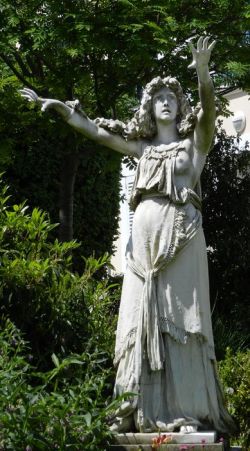
A 19th century CE statue of a female Druid, Potager du Dauphin à Meudon.
Cassius Dio, a Roman statesman and historian of Greek origin, in his Historia Romana (Roman History, c. 2nd century CE) mentions a female Druid named Ganna who went on an embassy to Rome and was received by Domitian, the younger son of the Emperor Vespasian, in about 70 CE. Curiously, numerous allusions to female Druids are made in the post-Druid-prohibition period of Roman history. The Historia Augusta (Augustan Histories, early 4th century CE) are a collection of biographies by six different authors that mention the following anecdotal (and probably satirical) references:
Aelius Lampridius, in his Alexander Severus – a biography of that Roman Emperor who reigned 222-235 CE – states that “as he went to war, a Druid prophetess exclaimed to him in her Gallic tongue, ‘Go ahead, but do not hope for victory or put any trust in your soldiers.'”
Flavius Vopiscus, in Aurelianus, records that “Aurelian (Roman Emperor, 270-275 CE) would consult Gaulish Druidesses to discover whether or not his descendants would continue to rule. They told him that no name would be more famous than those of the line of Claudius. And indeed, the current emperor Constantius is a descendant of his.”
The same author, in Numerianus – about Emperor Numerian (283-284 CE), tells us that “While Diocletian (who would be the next Emperor, 284-305 CE) was still a young soldier he was staying at a tavern in the land of the Tongri in Gaul. Every day he had to settle his account with the landlady, a Druidess. One day she said, ‘Diocletian, you are greedy and cheap!’ Jokingly he responded to her, ‘Then I’ll be more generous when I’m emperor.’ ‘Don’t laugh,’ she said, ‘for you’ll be emperor after you’ve killed the boar.'”
Irish folklore and myth is resplendent with accounts of female Druids known as bandruí (woman-druid – though they are often refered to as sorceresses or witches, depending on the translation) as well as male Druids (often refered to as magicians and wizards), Táin Bó Cúailnge (The Cattle Raid of Cooley, a part of the Ulster Cycle) and the Fhiannaíocht (the Fenian Cycle) are but two of them. The Mythological Cycle includes the story of the fight between the Tuatha de Danaan (Tribe of Danu – the gods) and the Fomóraiġ (Fomorians – probably meaning under(world) demons or nether demons) at The Second Battle of Moytura mentions two sister Druids – “‘And you, Be Chuille and Dianann,’ said Lugh [commander of the Tuatha de Danaan forces] to his two witches, ‘what can you do in the battle?’ ‘Not hard to say,’ they said. ‘We will enchant the trees and the stones and the sods of the earth so that they will be a host under arms against them [the Fomóraiġ]; and they will scatter in flight terrified and trembling.'” Not only is this another example of Elemental Magic it is also an excellent indication that the Druids were latterly believed to practice what is called Battle or Offensive Magic.
The Prohibition of the Druids and the Fall into Folklore and Myth:
There can be no question that the Druids were very influential in all levels of Celtic society when the Romans first invaded Gaul c. 130 BCE and then Britain in 43 CE, and it was about then that Druidism was outlawed within the Empire’s provinces. Professing revulsion for the Druidic human sacrificial rites, a practise they had outlawed among their own people in 97 BCE, the Romans decided to suppress the activities of the Druids almost as soon as they annexed Gaul c. 50 BCE but it wasn’t until about 40 CE that an outright prohibition was sought within the Roman provinces, which, within twenty years would include most of southern Britain. One should not doubt the Roman desire to clamp down on these perceived ‘barbaric’ rites, but it should also be remembered that the Druids were a unifying force within an otherwise disunified tribal society – so there were probably other motivations at play when they decided to wipe out the Celtic priesthood. The Druids of Britain were the last to rapidly decline under a remorseless onslaught that culminated in the attack on the island of Mona, it’s druidic inhabitants were slaughtered and the nemeton (sacred oak groves) burned and leveled – Tacitus suggested that it was the Britons themselves that kindled the flames, so perhaps the groves were burned by the funeral clad female torch carriers he described. Did they decide to destroy the holy trees ritually to prevent an unthinkable Roman defilement of them?
Lone individuals may have continued, becoming travelling wise men and women, ‘magicians’ and ‘witches’, or even bards, storytellers and itinerant sooth-sayers, carrying on the ancient wisdom as best they could. Effectively the age of the Druids, certainly within the parts of Europe under Roman influence, had passed. Druidism certainly carried on a little longer in Ireland, Scotland and, to some extent perhaps, Wales – which the Romans could never fully tame. The story of Vortigern, the legendary 5th century British warlord and alleged king of the Britons, as reported in the Historia Brittonum (History of the Britons – originally attributed to Nennius but probably compiled early in the 9th century CE from various sources), provides a rare glimpse at the possible survival of Druids in Britain after the Roman withdrawal. After being excommunicated by Saint Germanus, Vortigern seeks instead the council of twelve Druids (often translated as wise-men or wizards) to aid him in his rule. It is these Druids that advise him to seek out and sacrifice the young boy, Ambrosius Aurelianus, to placate two warring dragons beneath Dinas Emrys – where the king wants to build a citadel. Ambrosius Aurelianus and the previously mentioned Myrddin Wyllt were later conflated into Merlin Ambrosius (Myrddin Emrys in Welsh) – the wizard of Arthurian legend.

Detail of a fresco depicting the Christian oppression of the Druids, found in the basilica of St. Boniface’s Abbey, Munich. From Histoire Des Peintres, École Allemande, published 1875.
With the advancement of Christianity into Wales by the 4th century CE and into Scotland and Ireland by the 5th, Druidism soon declined in these places too. Simply moving into Christian legend, the Druids became sorcerers for the saints to combat and eventually defeat. In Adamnan’s Vita Columbae (Life of Columba, c. 700 CE) for example, two Druids act as tutors to the daughters of Lóegaire mac Néill, the High King of Ireland. These Druids endeavour to prevent the progress of Saints Patrick and Columba by raising clouds and mist. Before the battle of Cúl Dreimhne (between 555 and 561 CE) – essentially a battle caused by Columba stealing a copy of a book from Saint Finnian – a Druid named Fraechán made an airbe drtiad (fence of protection) round the Finnian sided army of King Diarmait, which eventually lost despite the supposed magical protection.
The priestly Druids did not survive in Wales certainly beyond the 7th century CE, interestingly the roles of Bard and of Seer (Welsh: dryw) were revived in the 10th century CE, by King Hywel Dda (the Good), and survived into the 13th century. We can use the few mentions of Druids in the early written law and lore of Ireland as an illustration of their fall from grace as Christianity became increasingly dominant there:
- 6th century CE—”Oaths may be sworn in the presence of druids” from the ‘First Synod of St Patrick’. Druids are members of the nemed, the free ‘privileged’ or ‘sacred’ ranks topped by the priests, nobles and kings, and still hold a high level of social status.
- 7th century CE—”the sick-maintenance [the recompense provided by an injurer to the victim] due to a druid, satirist [bard] and díberg [brigand – probably meaning a foot soldier] is no more than that due to a boaire [a free-man farmer/land-owner]” from the legal tract Bretha Crólige (Judgements of Blood-lying). Druids are now ranked at the lowest end of the free nemed.
- early 8th century CE— the Uraicecht Becc (Small Primer), that lists the social ranks of various classes, places the Druid among the dóer-nemed, the ‘subject’ artisan classes, which depend on a free patron for their living; along with wrights, blacksmiths and entertainers etc.
- 8th century CE—”Against the spells of women, and smiths, and druids … protect me” from the hymn The Breastplate, attributed to St Patrick. The Druid is now demoted to the level of a magical malcontent.
The prophetic poets of Ireland, the Fáith, remained members of the higher ranked nemed much longer than the Druids for they were able to adapt to Christianisation more easily and were essentially co-opted by the new Christian hierarchy. The later fortunes of the bardic systems of Ireland and Scotland were intricately linked to the Gaelic aristocracies that patronised them in each nation and, like those aristocracies, they lasted until the mid-17th century in Ireland and the early 18th century in Scotland. It is these bardic traditions that probably helped ensure that so much of the Celtic mythologies of Ireland, and similarly in Wales, survived from a much older oral tradition.
Traces of Druidism can be found in a number of these written myths and folklore – some of which have already been mentioned – dating from the Post Roman British Isles and the following Dark Ages and early Middle Ages, especially in the large body of Irish myths that include the not previously mentioned Historical Cycle. The earliest of these Irish myths were committed to writing c. the 11th and 12th centuries CE, though the prose can be dated on linguistic grounds to the 8th century, and some may be as old as the 6th century CE. This literature represents the most extensive and best preserved of all the branches of Celtic mythology.
The Welsh tales collected in the Mabinogion are the earliest prose literature of Britain. The eclectic collection of mythic stories were compiled in Middle Welsh in the 12th–13th centuries CE from earlier oral traditions that have many parallels with the Irish tales. These tales, along with those generally refered to as the Matter of Britain – the body of literature and legendary material associated with Britain and Brittany (variously from the 6th up to the 15th century CE) – include the first (and later) incarnations of the semi-mythic prophet-bard Taliesin, the much more mythic prophet-magician-wizard Merlin or Myrddin, and the entirely mythic witch-sorceress Morgan le Fay (variously Morgaine, Morganna and Morgant, among others – possibly derived from a British correspondent to the Irish goddess Morrigan). All of whom can be seen as bench-mark characters in the journey of the Druids as they slip from history into legend.
Bibliography and suggested reading:
Pufendorff, Esaias – Dissertation Upon The Druids, 1650 (Translated by Edmund Goldsmid 1886) (Read & Download HERE)
Davies, Edward – Mythology and Rites of the British Druids, 1809 (Read & Download HERE)
Guest, Lady Charlotte – The Mabinogion, 1877 (Read HERE, Download HERE)
, J. A. – The Religion of the Celts, 1911 (Read HERE, Download HERE)
Rolleston, T. W. – Myths & Legends of the Celtic Race, 1911 (Download HERE)
Wright, Dudley – Druidism the ancient faith of Britain, 1924 (Read & Download HERE)
Chadwick, Nora – The Druids, 1966 (Revised by Anne Ross, 1998) (Buy from Amazon.co.uk or Amazon.com)
Chadwick, Nora – The Celts, 1972 (Buy from Amazon.co.uk or Amazon.com)
Ellis, Peter Berresford – The Druids, 1994 (Buy from Amazon.co.uk or Amazon.com)
Kendrick, T. D. – The Druids, 1996 (Buy from Amazon.co.uk or Amazon.com)
Imbas – large website on Celtic Mythology and Celtic Studies, 2004 (LINK)
Parker, Will – The Four Branches of the Mabinogi, 2005 (Read HERE)
Cunliffe, Barry – The Druids: A Very Short Introduction, 2010 (Buy from Amazon.co.uk or Amazon.com)
Cunliffe, Barry & – Celtic from the West. Alternative perspectives from archaeology, genetics and literature, 2010 (Buy from Amazon.co.uk or Amazon.com)
Celtic Literature Collective – Massive website collecting translations of historical texts, 2016 (LINK)
___
Part Two of this article will look at how popular perceptions of the Druids have changed over the years, taking in misconceptions regarding the Druids, the Druid Revival of the 17th and 18th centuries, Neo-Druidism in the 19th and 20th centuries and how Druidism has been depicted in fiction – from the Romanticism movement onwards – in film and then games – specifically fantasy role-playing-games. Coming SOON!
This is also the first in a series of articles that will be looking at the origins of a wide range of magic-users in Fact, Folklore and Fiction – including Witches, Warlocks and Wizards among others.
The Horror of it All… enter HERE all those who delight in horror, death, the macabre, the occult, black humor, weird tales, dark fantasy – and all such nefarious pleasures.
Copyright © 2017 Harbinger451 – All Rights Reserved



